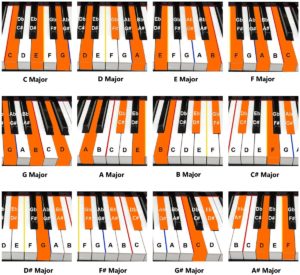How to Form Major Chords on Piano for beginner

The root is the note upon which the chord is based. For example, the root of G major is G, no matter what the inversion.
The major third is the third note in a major scale. Using the same note G, as an example, the major third is B. B is four half steps above the root note.
The perfect fifth is the fifth note in the major (or minor) scale. It is seven half steps above the root note. Using the note G again, the perfect fifth is D. D is three half steps above the major third.
Clearly, you can form this type of chord by using half steps. The formula is R + 4HS + 3 HS (root plus 4 half steps + 3 half steps).
Take a look at your piano keyboard. Play any key. To form a major chord corresponding to that key or note simply hold that note, then skip two keys and play the key to the right, then skip two keys and play the key to the right.
Key Patterns for all 12 major triads
Perhaps the easiest major chords to play on piano are the chords, C, F and G. This is due to the fact that the consist of white notes only. We’ve already looked at C and F. The notes for G major are G, B and D.
There are three chords which follow the pattern, white key, black key, white key. These are the chords, D, E and A major.
Three major triads are made up of the pattern black key, white key, black key. They are Db, Eb and Ab.
Lastly, there are three chords with an odd pattern. Gb major consists of all black keys, Bb major is made up of the pattern, black key, white key, white key, and B major, white key, black key, black key.
Practice the all white key chords first, then move to the other patterns we highlighted above in the other presented.


 Cooking Smarter
Cooking Smarter